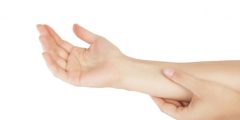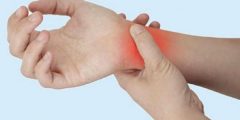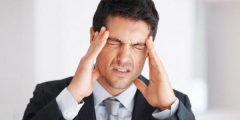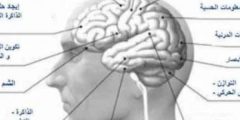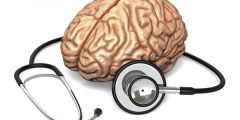Causes of sciatica
Although determining the cause of sciatica may not be possible for some, this pain that spreads along the sciatic nerve to the foot is due to the exposure of the sciatic nerve or the roots of the spinal nerve to pressure, damage, or inflammation, and it is worth It should be noted that sciatica is not a medical diagnosis in itself, but rather a description of a group of symptoms resulting from a specific health problem. Therefore, understanding the possible causes of sciatica contributes to focusing on treating the root of the problem instead of being satisfied with the idea of hiding the symptoms. In this part, it will be reviewed. Some common health problems that may cause sciatica.
Disc protrusion or herniation
Herniated disc is defined as a bulge or protrusion of the disc, which is one of the most common causes of sciatica. It is also a relatively common injury among individuals, which often exposes one or more nerve roots in the area. (L2 - S3) for pressure, which are the nerve roots that form the sciatic nerve. Sciatica may occur as a result of a herniated lumbar disc in two ways. The first way is when the sciatic nerve is exposed to direct pressure, whether as a result of the protrusion of the lumbar disc, or the herniation that occurs through the fibrous part of the sciatica. The outer nucleus, which in turn puts pressure on the nerve, or as a result of the leakage of the soft internal material from the disc. As for the second method, it is related to the leakage of an irritating chemical substance from the disc material, which results in inflammation and irritation in the area surrounding the sciatic nerve.
Read also:What are the causes of nervousness?It should be noted that there are several reasons and factors that may make the disc vulnerable to herniation and protrusion, including: repetitive movement, suffering from excess weight, exposure to severe injuries, carrying things incorrectly, or even as a result of aging, as the chance of exposure to disc injuries increases with age. As we age, with the passage of time, the condition of the intervertebral disc begins to deteriorate, becoming drier, and this may make it worn out and cracked. In addition to the above, there are genetic factors that make the individual more susceptible to a herniated disc or degeneration of the intervertebral discs.
Bump or osteophyte
Bone spurs are defined as a protrusion or bone growth that forms on the edges of the joints in the place where cartilage wears away and bones rub against each other in an attempt to protect the body, for example, as happens in the case of degenerative arthritis. In fact, these bone spurs do not cause severe It is the feeling of pain, but the pain may arise as a result of the friction of the bony prominence with nearby nerves or bones, which causes some problems. However, when bony prominences appear in the spine, they may enter the space that is normally designated for nerves, which may result in the occurrence of sciatica. .
Spinal stenosis
Spinal stenosis occurs when the space surrounding the spinal cord, known as the spinal canal, is narrowed as a result of arthritis, deformities in the vertebrae, degeneration of the intervertebral discs, or certain health problems such as rheumatoid arthritis. ), or Paget's disease, or ankylosing spondylitis. On the other hand, there is a narrow lumbar spinal canal in the lower part of the spine, from which the nerves extending to the legs emerge. Therefore, continued bone growth Over the years, other tissues around the lumbar spinal canal may cause the canal to become more narrow. Therefore, lumbar spinal stenosis in this case occurs on its own without the intervention of external factors. However, a group of other causes and factors may lead to the occurrence of spinal stenosis in the lower lumbar region. Back, such as falling, arthritis, exposure to a certain accident, or damage to the bones and joints in the spine.
Read also:Treatment of left leg numbnessWhen the lumbar spinal canal is narrowed, the nerves that pass through this canal are exposed to pressure, which may be accompanied by a feeling of pain or numbness in the leg. The affected person may also feel cramps, weakness, or fatigue in the legs. These symptoms usually begin when standing or while walking, and may improve and become It is better when sitting, bending, or lying in the fetal position, in which the knees are bent and raised to the chest. There is a belief that these positions help open the lumbar canal and remove pressure affecting the nerves that reach the legs. As for severe cases of lumbar spinal stenosis The affected person may suffer from partial or complete incontinence of the bladder or intestines.
Spondylolisthesis
Spondylolisthesis is defined as the disorder resulting from one of the vertebral discs pushing and sliding over the disc located below it, which leads to a narrowing of the spinal canal space at the point where the slip occurs, and may result in pressure that affects the nerve roots and spinal cord, and it is possible for sweating to occur. Sciatica in the case of spondylolisthesis in the lumbar region, which often affects the fourth and fifth lumbar vertebrae. In fact, there are many reasons that may lie behind the occurrence of spondylolisthesis, as it may occur as a result of a fracture of the vertebra due to exposure to trauma or stress, and the vertebra may also be injured. Deformed from birth, the vertebrae may also be fractured as a result of infection or disease sometimes. In addition, this disorder usually occurs in children and adolescents who practice sports, such as gymnastics, for example.
Read also:What is trigeminal nerve disease?
Piriformis syndrome
Piriformis syndrome is known as the irritation that affects the sciatic nerve under the influence of the piriformis muscle located in the buttocks, causing sciatica. The occurrence of this syndrome may be attributed to prolonged sitting accompanied by the presence of a wallet or anything else in the back pocket, and to avoid this problem occurring It is always recommended to place the wallet in the front pockets.
other reasons
A group of other causes that may result in sciatica can be mentioned as follows:
- Space-occupying lesions: The presence of lesions such as tumors, clots, and abscesses in the space in the lumbar region results in pressure that affects the lumbar nerve roots or the sciatic nerve itself. Although spinal tumors are rare, tumor growth in the spine, specifically in the lumbar region, may increase the risk of Sciatica is caused by pressure on the sciatic nerve.
- Infection or injury: Sciatica may occur if the nerve roots in the lumbar region or sacrum are affected by direct pressure as a result of the impact of forces from outside the body, such as what occurs as a result of a fall, exposure to car accidents, or playing football or other sports that make the individual vulnerable to injuries and fractures. In addition Direct impact on the nerve: Parts of the broken bones may put pressure on the nerves and cause pain. Not only that, in rare cases, sciatica also occurs as a result of infection or inflammation, and sometimes it is difficult to determine the main cause of this problem. In general, any condition that exposes the sciatic nerve to pressure Direct or irritation can cause the problem of sciatica.
Sciatica risk factors
Most of the factors that make some people more susceptible to sciatica are related to the lifestyle that the individual follows, in addition to some other factors. A number of risk factors for sciatica can be summarized as follows:
- Age: Aging is one of the main factors that increase the risk of sciatica, due to the increased possibility of loss of flexibility in the spinal discs, and deterioration of the spine and the body in general. Age-related changes that occur to the spine, such as a herniated disc, the appearance of bone spurs, and spinal stenosis. It is considered one of the most common causes behind the occurrence of sciatica, and in general, people between the ages of 30 and 50 years are most at risk of developing sciatica, and this is due to the tendency of this age group to engage in activities compared to older age groups, such as social and sports activities. And work, which increases the possibility of injury or other types of damage, in addition to advanced age.
- Obesity: Excess weight, especially in the abdominal area, increases the amount of stress affecting the spine.
- Occupation: Occupations that require carrying heavy weights, twisting the back, or driving a car for a long period of time may play a role in the development of sciatica, although there is no conclusive evidence of this link.
- Sitting for long periods: Individuals who follow a sedentary lifestyle, devoid of movement, or who sit for long periods are more susceptible to sciatica compared to people who are very active and active.
- High heels: One of the disadvantages of high-heeled shoes, especially those with thin heels, is that they may not provide adequate and appropriate support for the back area, which may result in sciatic pain.
- diabetes: The chance of nerve damage increases as a result of diabetes, a health problem that affects the way the body handles blood sugar.
- smoking: Nicotine in tobacco may cause weak bones, accelerate the wear of spinal discs, and damage spinal tissue.
- pregnancy: Sciatica is one of the common problems during pregnancy. In addition to weight gain during this period and the effect of the child’s weight and position in increasing the pressure affecting the nerve, the chance of developing sciatica also increases during pregnancy as a result of the presence of certain hormones in the pregnant woman’s body that contribute to relieving the tension of the ligaments. The body, including the ligaments responsible for holding the vertebrae together, protecting the intervertebral discs, and maintaining the stability of the spine, which may result in instability of the spine, and the possibility of disc slippage, and this may contribute to pressure on the nerves and cause sciatica, and although pain Sciatica that occurs during pregnancy goes away after birth, but a number of different methods can be followed to relieve this pain during pregnancy, such as physical therapy, massage therapy, taking a warm bath, and using heat, medications, and other means that help relieve pain. Women should also Pregnant women must ensure that they follow appropriate techniques for their body position, which may also contribute to alleviating the problem of sciatica.
- Not adopting a proper posture: An individual is at risk of developing sciatica if he does not adopt a suitable position for his body while lifting weights or performing other strength exercises, even if he is physically active and fit.
Tips to prevent sciatica
There are a number of modifications that can be made in the lifestyle followed, which may sometimes contribute to reducing the chance of developing sciatica and preventing it, and these tips include the following:
- Exercising regularly. In this area, you must focus on strengthening the trunk muscles, which are the muscles in the lower back and in the abdominal area, which are necessary to keep the body in an upright and appropriate position. For example, it is recommended to repeat abdominal exercises 10 to 20 times during the day, as these exercises contribute to Strengthening the muscles of the abdominal area, which may help support the lower back muscles, but before starting a specific exercise, it is recommended to consult a doctor and take his recommendations regarding practicing certain types of sports activities.
- Practicing the correct body positions. While standing, you must ensure that the ears remain in line with the shoulders, the shoulders are in line with the hips, and the buttocks are folded, and the knees are slightly bent. To ensure that the body remains in an appropriate position while sitting, you must choose a seat that provides sufficient support for the lower back area, which It also contains armrests and a swivel base, taking into account placing a pillow or wrapped towel in the back area, in order to maintain the natural curvature of the back, and the knees and hips must be kept at the correct level. When sleeping, it is recommended to lie on one side. On the body or on the back with a pillow under the knees. This is the appropriate position for sleeping and contributes to relieving pressure affecting the back.
- Carrying things in a safe way, as it is always recommended to adopt a squat position when carrying and lifting things, in which the weight is concentrated on the hips and legs, while avoiding bending while keeping the back straight.
- Walking and swimming. Walking and swimming can help strengthen the lower back.
- Stretching. This can be achieved by sitting on a chair and bending down towards the ground. It is recommended to repeat this exercise 6-8 times.
- Avoid standing or sitting for long periods.
- Avoid wearing high heels, as high-heeled shoes that exceed 3.81 cm in height contribute to shifting the body weight forward, and thus the body remains in an inappropriate position.
- Quit and avoid smoking, as smoking contributes to disc degeneration.

